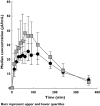Acute passive cigarette smoke exposure and inhaled human insulin (Exubera) pharmacokinetics
- PMID: 18477263
- PMCID: PMC2485222
- DOI: 10.1111/j.1365-2125.2008.03122.x
Acute passive cigarette smoke exposure and inhaled human insulin (Exubera) pharmacokinetics
Abstract
What is already known about this subject: Active cigarette smoking is associated with increased permeability of the pulmonary alveolar epithelium, resulting in faster absorption of inhaled drugs such as Exubera (EXU). Absorption of EXU is increased approximately twice to four times as much in chronic smokers compared with nonsmokers. The rate of clearance of radioaerosols such as technetium-labelled diethylenetriamine penta-acetic acid is decreased in response to passive smoke exposure.
What this study adds: Passive smoke exposure causes a decrease in lung permeability, an effect opposite to that of active smoking. Acute passive smoke exposure results in a decrease in EXU bioavailability and does not create a risk of hypoglycaemia. These results are consistent with previous studies of radioaerosol lung clearance. AIMS Relative to nonsmokers, the bioavailability of inhaled human insulin (Exubera(R); EXU) is markedly increased in chronic smokers. The pharmacokinetics of EXU following passive cigarette smoke exposure is unknown. METHODS In an open-label, crossover study, healthy nonsmoking volunteers received two treatments in randomized sequence separated by a 2-week wash-out: (i) EXU 3 mg with no passive smoke exposure and (ii) EXU 3 mg after passive smoke exposure (atmospheric nicotine levels 75-125 mug m(-3)) for 2 h. Blood samples were obtained at prespecified times up to 6 h after EXU administration.
Results: Twenty-seven subjects completed both study periods. Mean plasma insulin AUC(0-360) decreased by 17% [ratio 83%, 95% confidence interval (CI) 68.8, 99.5] and mean C(max) by 29% (ratio 71%, 95% CI 59.8, 83.1) after passive cigarette smoke exposure. The median (range) t(max) was 60 min (20-120 min) and 75 min (20-360 min) in the EXU with no exposure and EXU passive exposure groups, respectively. EXU was well tolerated.
Conclusions: Unlike active chronic smoking, acute passive cigarette smoke exposure modestly decreases EXU bioavailability and thus should not increase hypoglycaemia risk. These results are consistent with those from published literature involving technetium-labelled diethylenetriamine penta-acetic acid and suggest that passive cigarette smoke exposure causes an acute decrease in lung permeability vs. active smoking, which causes an increase in permeability.
Figures
Similar articles
-
Effects of smoking cessation, acute re-exposure and nicotine replacement in smokers on AIR inhaled insulin pharmacokinetics and glucodynamics.Br J Clin Pharmacol. 2008 Apr;65(4):480-7. doi: 10.1111/j.1365-2125.2007.03041.x. Epub 2007 Oct 8. Br J Clin Pharmacol. 2008. PMID: 17922880 Free PMC article. Clinical Trial.
-
The effect of smoking cessation and subsequent resumption on absorption of inhaled insulin.Diabetes Care. 2006 Feb;29(2):277-82. doi: 10.2337/diacare.29.02.06.dc05-1913. Diabetes Care. 2006. PMID: 16443873
-
Randomized study to characterize glycemic control and short-term pulmonary function in patients with type 1 diabetes receiving inhaled human insulin (exubera).J Clin Endocrinol Metab. 2007 Jun;92(6):2211-4. doi: 10.1210/jc.2006-0631. Epub 2006 Sep 26. J Clin Endocrinol Metab. 2007. PMID: 17003088 Clinical Trial.
-
New ways of insulin delivery.Int J Clin Pract Suppl. 2010 Feb;(166):29-40. doi: 10.1111/j.1742-1241.2009.02276.x. Int J Clin Pract Suppl. 2010. PMID: 20377662 Review.
-
Inhaled insulin--does it become reality?J Physiol Pharmacol. 2008 Dec;59 Suppl 6:81-113. J Physiol Pharmacol. 2008. PMID: 19218634 Review.
Cited by
-
Inhaled insulin is associated with prolonged enhancement of glucose disposal in muscle and liver in the canine.J Pharmacol Exp Ther. 2009 Mar;328(3):970-5. doi: 10.1124/jpet.108.146985. Epub 2008 Dec 19. J Pharmacol Exp Ther. 2009. PMID: 19098161 Free PMC article.
-
Inhaled insulin: overview of a novel route of insulin administration.Vasc Health Risk Manag. 2010 Mar 3;6:47-58. doi: 10.2147/vhrm.s6098. Vasc Health Risk Manag. 2010. PMID: 20234779 Free PMC article. Review.
-
A Review of the Impact of Smoking on Inhaled Insulin: Would You Stop Smoking if Insulin Can Be Inhaled?Cureus. 2020 Jul 23;12(7):e9364. doi: 10.7759/cureus.9364. Cureus. 2020. PMID: 32850233 Free PMC article. Review.
References
-
- Nelson E. The miseries of passive smoking. Hum Exp Toxicol. 2001;20:61–83. - PubMed
-
- Office of Environmental Health Hazard Assessment. Health Effects of Exposure to Environmental Tobacco Smoke. [March 2006]. Final Report September 1997. Available at http://www.oehha.org/air/environmental_tobacco/finalets.html.
-
- Miller LG. Cigarettes and drug therapy: pharmacokinetic and pharmacodynamic considerations. Clin Pharm. 1990;9:125–35. - PubMed
-
- Zevin S, Benowitz NL. Drug interactions with tobacco smoking: an update. Clin Pharmacokinet. 1999;36:425–38. - PubMed
-
- Groth S, Mortensen J, Lange P, Vest S, Rossing N, Swift D. Effect of change in particle number on pulmonary clearance of aerosolized 99mTc-DTPA. J Appl Physiol. 1989;66:2750–5. - PubMed
Publication types
MeSH terms
Substances
LinkOut - more resources
Full Text Sources
Medical


